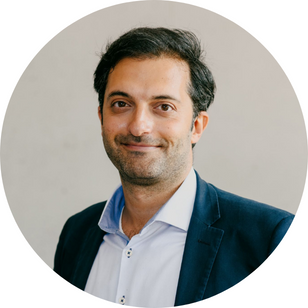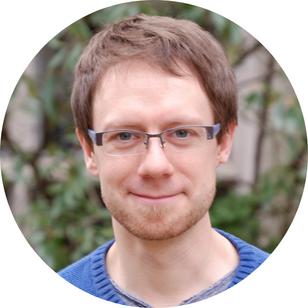Applications
 Part of the Oxford Instruments Group
Part of the Oxford Instruments Group
Expand
Collapse
At Oxford Instruments NanoScience, we caught up with Professor Angelo Di Bernardo and Dr Alexander Grimm to ask them how they are feeling after being named joint winners of the Nicholas Kurti prize and to find out where they think their research will take them next.

Professor Angelo Di Bernardo, Associate Professor at the University of Konstanz
The Award recognises Di Bernardo’s achievements in the spectroscopy of spin-polarised (spin-triplet) states in superconductor/ferromagnet hybrids and for the discovery of new coupling effects and quantum phases existing at the surfaces and interfaces of strongly-correlated electron materials and materials with low dimensionality.
Follow Angelo’s work here!
“I feel honoured for having been awarded this prestigious prize, since the Nicholas Kurti prize acknowledges the importance of the research work that I have been carrying out with great dedication and passion throughout my academic career.
After being notified of having won this prize, I immediately shared the joy which I feel for this achievement with my loved ones. The feeling which I experienced whilst sharing my success is surely what turned this achievement of mine into a special moment to remember and treasure.”
“I have been awarded the Nicholas Kurti prize for discovering several states existing at the surfaces and interfaces of materials with different properties, as well as for my studies focusing on the exploitation of effects originating from these states for low-dissipation superconducting electronics.
So far in my academic career I have made important contributions to the field of superconducting spintronics. We are currently studying spin-triplet supercurrents, which carry a non-null spin, in the research group that I lead at the University of Konstanz to realise spintronic devices with low energy dissipation.
In the early years of my career, I demonstrated the first direct evidence for the existence of spin-triplet states. Later in my career, I demonstrated that spin-triplet states can be triggered in single-layer graphene coupled to a high-temperature superconductor or at the interface of chiral molecules with a superconductor.
Other results acknowledged by the Kurti prize include the discovery of an unknown form of coupling between ferromagnets mediated by a high-temperature superconductor and the recent demonstration of the existence of an unknown magnetic phase at the surface of the unconventional superconductor Sr2RuO4. All these physical effects and unknown phases are not only of fundamental physical interest, but they can also pave the way for new superconducting devices.”
“Something that makes me particularly proud is the fact that some of my projects originated from ideas that were considered absurd. For example, when I suggested to some close collaborators of mine that it would be possible to induce a new type of superconductivity in graphene when placed onto a high-temperature superconductor, they replied that this would be impossible as a monolayer of graphene would have not altered the order parameter of the superconductor underneath. I insisted on carrying out this project and the results proved my hypothesis was right.
Similarly, my intuition that an oxide high temperature superconductor could be used to couple two ferromagnetic insulators sandwiching it, went against all the theories available at the time, which suggested this is not possible in an oxide high-temperature superconductor due to its short coherence length. Once again, I went to the lab, optimised the samples’ growth and properties for several months, until the low-temperature measurements gave the results which I had expected.
Finally, when I recently decided to look for surface magnetism using low-energy muon spectroscopy at the surface of Sr2RuO4, a lot of experts thought I would not find any evidence for magnetism, since many other groups had tried without success. However, the course of events suggests I was right to follow my intuition."
“I am currently working on a variety of topics, thanks to the support of a research team consisting of many talented and motivated young researchers whom I have the pleasure of supervising at the University of Konstanz. We are working on the integration and testing of new materials in different physical systems of interest, with the goal of discovering unknown physical phenomena and effects. Building upon the exciting new effects that we discover, we then engineer and test devices that have applications in low-dissipation digital superconducting electronics and quantum computing.
A key example of the combined fundamental/technological approach that we are taking is given by a research program that I recently designed with the support of other collaborators, and for which we have been awarded a Future and Emerging technology (FET) grant by the European Union. Through this research programme named SuperGate, we are trying to develop the first generation of superconducting logics based on three-terminal gate-controlled devices.”
“The prize surely represents an important recognition for the significance of my research work, and I am sure that it will play an essential role towards my future establishment as world-renowned scientist in the field of superconducting and quantum devices based on novel materials systems and physical effects.”
“I would like to leave a message for the young scientists that are often afraid of the competitiveness and stress that they must face in the academic world, and which can often be very discouraging. I would like to tell these young researchers that academic life can indeed be stressful sometimes, but it is one of the few jobs that eventually pays off hard work with great personal satisfaction. Good results in science always come, especially for those who are willing to work hard and to dare to think out of the box, which is what really makes our job great fun.”
Dr Alexander Grimm, researcher in the Photon Science Division at the Paul Scherrer Institut
Grimm earned his place as an Award winner for his work on non-linear effects in Josephson junctions for quantum information processing, involving:
i) the experimental demonstration of anti bunching statistics in the photons emitted by inelastic Cooper-pair tunnelling through a voltage-biassed Josephson junction
ii) The creation of a novel autonomously stabilised qubit in a two-photon driven Kerr-nonlinear superconducting resonator.
Keep up to date with Alexander’s work here!

“Absolutely amazing. It is of course a great honour to receive this prize, in particular because it further emphasises the growing importance of quantum microwave emission through inelastic Cooper pair tunnelling (sometimes called Josephson photonics) and of bosonic quantum error correction.”
“It essentially involves two parts: On the one hand, it includes experiments I performed during my PhD thesis at the CEA Grenoble. Those experiments were based on applying a voltage bias to a Josephson junction and observing the microwave radiation that is emitted. Intuitively, one would expect that no current can flow through the junction, because the two Cooper-pair condensates on either side of the junction are misaligned in energy. But it turns out that the Cooper pairs can tunnel inelastically by emitting their surplus energy into electromagnetic modes of the junction. Now you can engineer these modes to in turn influence the statistics of the emitted radiation. That is exactly what we did to create a fast on-demand single photon source at microwave frequencies.
On the other hand, I also performed experiments with exotic states of microwave light during my postdoc at Yale university. Here the focus was on finding ways to use these states to robustly encode quantum information. Our efforts there culminated with the demonstration of a new kind of qubit called the "Kerr-cat" qubit.”
“I am of course very happy to have been part of all the research we conducted during my PhD and postdoc and of the amazing teams that were involved in it. I would have to say that the part that stands out most to me is helping to build up a lab together with my PhD supervisor. Our goal was to get from an empty room to tangible results within some three-and-a-half years, which was the maximum duration of a PhD at my institute. This ended up being an exciting and at times unnerving scientific and personal journey for me with lots of obstacles we had to overcome. I am really very proud that we made it in the end. Of course this experience is now also useful for building up my new research effort at the Paul Scherrer Institute (PSI) in Switzerland.”
“I think both of these research fields are young, emerging, and active so I am excited to further explore nonlinear processes in Josephson junctions and their application to bosonic quantum information processing. This is what we will do in my new group at PSI.”
“My first plan is to go out to have a nice dinner. Preferably, it should be molecular gastronomy. After all, Nicholas Kurti had a leading role in developing this gastronomical trend.”
“I would like to thank all my collaborators and coauthors. Scientific results in our field are always a group effort.”